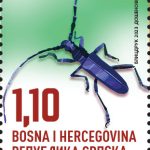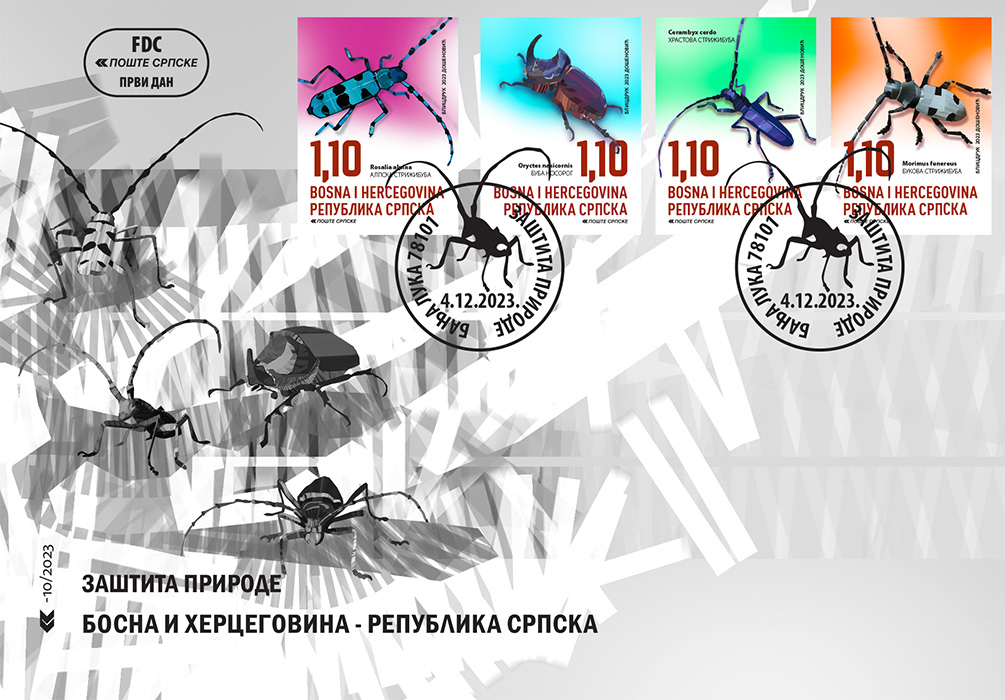Nature protection 2023
Title:: Nature Protection
Date of Issue: 04.12.2023.
Author: Bozidar Dosenovic
Type edition: commemorative
Printing techniques: multicolour offset
Sheet: 20
Paper: muflep 100g
Printing House: Blicdruk, Sarajevo
 Motive: Rosalia alpina Linnaeus
Motive: Rosalia alpina Linnaeus
Catalogue no.: 945
Perforation: 13 3/4
Face value: 1.10 BAM
Quantity: 10 000
 Motive: Cerambyx cerdo Linnaeus
Motive: Cerambyx cerdo Linnaeus
Catalogue no.: 946
Perforation: 13 3/4
Face value: 1.10 BAM
Quantity: 10 000

Motive: Morimus funereus Mulsant
Catalogue no.: 947
Perforation: 13 3/4
Face value: 1.10 BAM
Quantity: 10 000

Motive: Oryctes nasicornis
Catalogue no.: 948
Perforation: 13 3/4
Face value: 1.10 BAM
Quantity: 10 000

Coleoptera (order Coleoptera) represent the most numerous group of insects and in general of all living organisms on the planet, with about 400,000 species described so far. With this postal issue, we present several protected species of beetles. Some of them are also at risk of extinction in nature.
Rosalia alpina Linnaeus, (Alpine longhorn beetle) inhabits the area from southern Sweden to the Balkan Peninsula, all the way to the Caucasus, i.e. Syria and Palestine. Adults emerge from mid-July to mid-August. They can be found during sunny days on rotten or fallen trees. The female lays eggs in beech trees. The development of the larvae is not well known, but it is known that the total development in these areas takes 3-4 years.
Cerambyx cerdo Linnaeus, (Great capricorn beetle) is a Palearctic species whose range is decreasing, especially in the northern areas of Europe. It inhabits almost the entire Republic of Srpska in areas where there are oak forests. As a rule, it appears on lonely and sunny trees. The female lays her eggs on old oak trees, and the larvae feed on parts of the tree. Development takes 3-4 years. Adults usually emerge from mid-May to mid-June.
Morimus funereus Mulsant (Beech Longhorn beetle) inhabits a wider area of Europe and is often present in deciduous forests in the Republic of Srpska. Development to the adult stage takes 3-4 years. Adults can be found from April to August. The typical habitat of the beech beetle is beech forests. It feeds on the wood mass of various woody species, and it is also known that they feed on the sap of woody species. Females lay their eggs on beech trees, in pits they dig with their jaws. Adults are poorly mobile animals with a lifespan of about two years.
Oryctes nasicornis (Rhinoceros beetle) inhabits the Palaearctic region, except for the British Isles. It prefers deciduous forests, located along the banks of rivers and above meadows. They often find shelter in tree bark and other similar places. It lives in trees, in hollows, and large larvae can be found in rotten stumps. They are quite good flyers and have been recorded flying tens of kilometers without rest. The head of the male is decorated with a characteristic and impressive, relatively large and curved horn.
Author: MA Bozidar Dosenovic
Publisher: Poste Srpske a.d. Banjaluka
Cooperation: Dejan Radosevic, BA in Ecology, Republic Institute for Protection of Cultural and Natural Heritage



